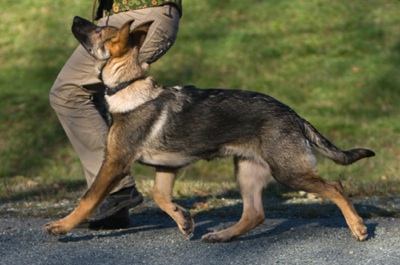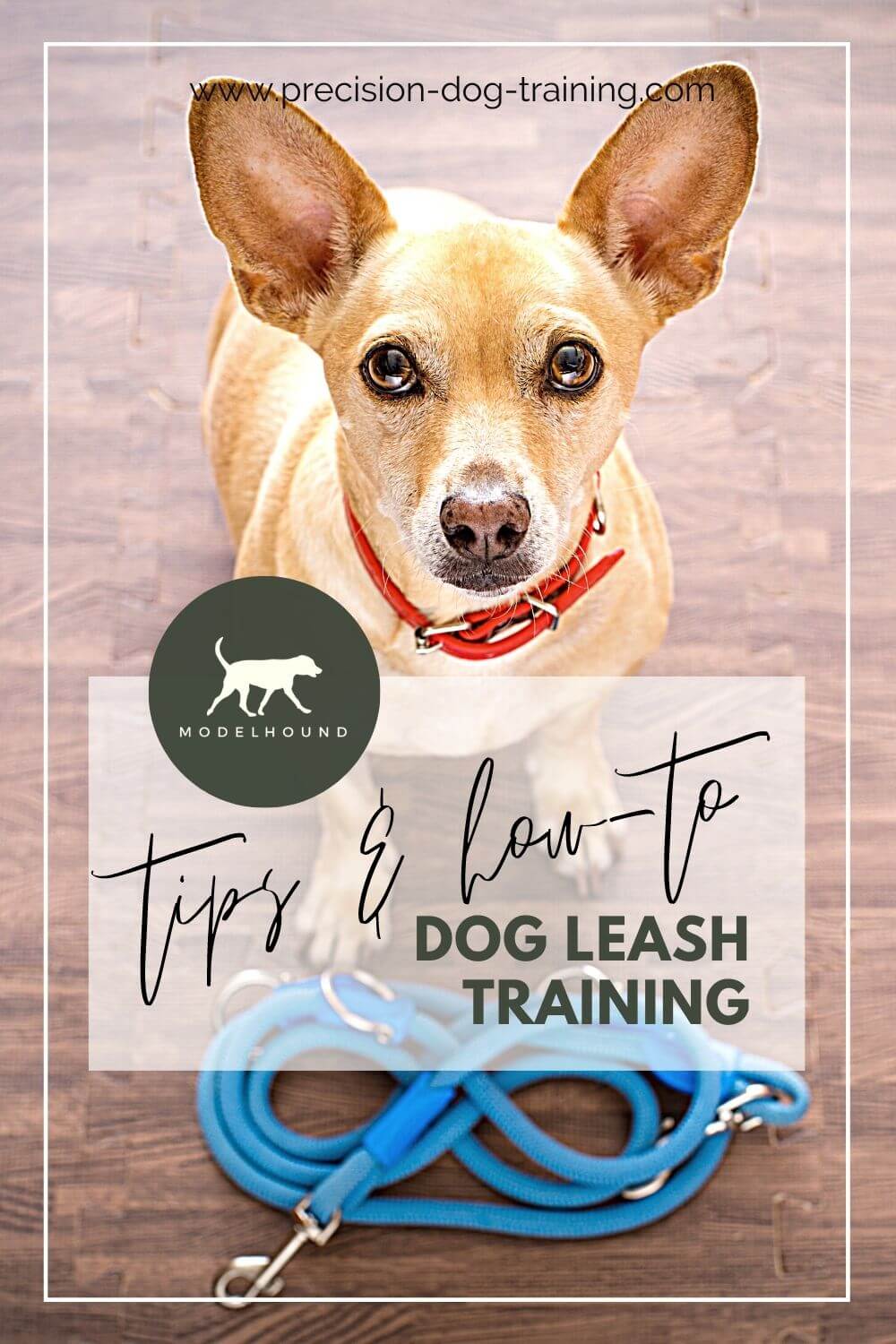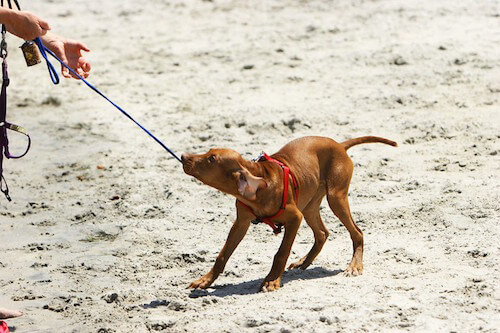A No-Fail Plan for Dog Leash Training
Dog leash training is a must for our pets, particularly if you live in the city! Everywhere you go in public today, your dog must be leashed, with the exception of leash-free dog parks (which I don't recommend!).
Now, there are two ways you can go about this...
- Have your leashed dog pull your arm out of its socket while he follows his nose madly along the sidewalk and to each tree, jumping on everyone you pass, and making you think twice about trying that again, OR
- Train him to walk nicely beside you, making every time you take him out on a leash a pleasure and an enjoyable experience!
As a responsible dog owner, you must be able to have your dog under control at all times. It's not acceptable for your pet to jump on passing pedestrians or dogs, nor should he be allowed to drag you down the street.
Naturally, he needs a firm leader otherwise he will take over and become the 'leader' in your home and life. I'll bet you're thinking - right, you lost me at "control"! Trust me, I have been in that exact same place before...
Oh yes, at one time, I was that crazy neighbor who had the leash wrapped around my arm ten times and was being pulled around the block by a spastic dog. I really did love her :) Especially once she was walking with me, instead of in front of me!
Even if you live on the other side of the world, I still want to be able
to help you with dog leash training. I'm a firm believer that you can't train a dog by reading a
book or watching a movie, so I recommend that you find a certified
balanced trainer in your area, too, if you can. That being said, I understand that it isn't always in the cards, whether due to affordability or trainer availability.
Anyways, without further adieu, here it is:
Dog Leash Training 101
Before you begin to train your dog to walk on a leash, you need her to be comfortable with wearing one! Dog leash training is a lot easier when she isn't fighting the leash. How do you do this? Take about a week to "desensitize" your puppy or dog to the leash and collar.
Just have him wear it around the house to start. Don't teach him to go get the leash, as this will encourage leash biting and chewing!
On a side note, if you do notice that your dog (or puppy more likely, as they love to chew!) is chewing or mouthing the leash while simply getting used to it, there's a couple things you can do to correct the behavior:
- Prevent - Never let your dog fetch the leash for you! A dog can't understand the difference between having it in his mouth to fetch it or grabbing it while on a walk, and it will make your dog leash training that much more difficult.
- Prevent - Spray the leash with bitter apple spray to prevent chewing in the first place. The awful taste should stop any mouthing or chewing. That being said, some dogs don't seem fazed by it... which leads us to #3.
- Give your pooch a quick pop under the chin with the top of your closed hand while the leash is in his mouth. You are not punching your dog, but simply startling him enough to drop the leash, at which point you should praise him!
- Try tying a shoelace to your dog's collar, and use it to give a firm "loosen, pop, loosen" while the leash is in his mouth. Never try to pull the leash out of a dog's mouth, as he'll think you're after a great game of tug-of-war.
 Dog leash training brings the joy back to a walk!
Dog leash training brings the joy back to a walk!Also at this time, find a dog training collar that is suitable to your dog's temperament, not necessarily her size or breed.
For puppies under 3 months of age, stick with a plain-Jane flat buckle collar (the kind that looks like a belt).
Desensitize her to
this collar as well in the same way as for the leash. With my puppy Milo, I put his collar on, then immediately feed him dinner. Put the
collar on and give him a treat. Put it on and play. Put it on for
napping. You get the idea...
Your puppy or dog can wear the collar all day as long as someone is home; just make sure that you don't crate him, tie him out or leave him alone with it on.
It's also pretty important to first tackle training your dog to sit, before attempting heeling. The reason for this is that "sit" is the foundation position that your dog will be starting from and ending in. Each and every time you stop walking, your dog should be sitting straight at your side - it goes hand-in-hand with the calm, controlled leash walking that we're after!
Once through this process, it's time to teach him to heel. Yay! Just a quick note...
I have a problem with simply teaching a dog "loose leash walking". You can bet your dog will still walk ahead of you, even if it's a loose leash. And that's a big part of the problem - the dog acting as the leader of the walk!
So start out by getting your pup to sit on your left hand side (it helps to have already taught him how to sit).
After he's sitting nicely, say "Milo, heel!" in a happy, upbeat tone of voice while stepping forward with your left leg. He'll pick up on this foot signal very quickly and be able to differentiate which foot you lead with.
Keep talking to him as you heel - it makes things more interesting for both of you, and he'll pay more attention to you than the other distractions! The leash should be loose at all times. Ahem, easier said than done, am I right?
Solutions to Common Problems While Dog Leash Training
When your dog or puppy tries to pull you or even go ahead of your left
ankle by a couple inches, say nothing, and simply loosen the leash, pop back horizontally,
and loosen the leash again. It should be a fast, firm correction where
the collar goes tight for only one second. Don't say anything when you correct! Actions really do speak louder than words - and dogs don't understand English anyways.
Don't pop your dog forward if they lag behind you, though; just coax them along with your voice or a little treat. Something soft and smelly works the best!
For sniffing, the most effective correction is to loosen the leash, pop up vertically, and loosen it again (a one second correction).
This should get you well on your way to teach your dog or puppy to heel beside you. Dog leash training is sometimes frustrating simply because you don't know how to properly correct! I hope this has been helpful... if so, let us and our other visitors know!
After you've worked on basic dog obedience training and your dog is consistently listening to you while on leash, you may be ready to move on to dog training off leash!
But don't rush it, whatever you do. I won't expect my dog to be able to be reliable off leash after on-leash training (whether that's with a 6 foot leash or a long line to work at a distance) for about 6 months.
- Home
- Basic Training
- Leash Training
- Home
- Dog & Puppy Care
- Leash Training



